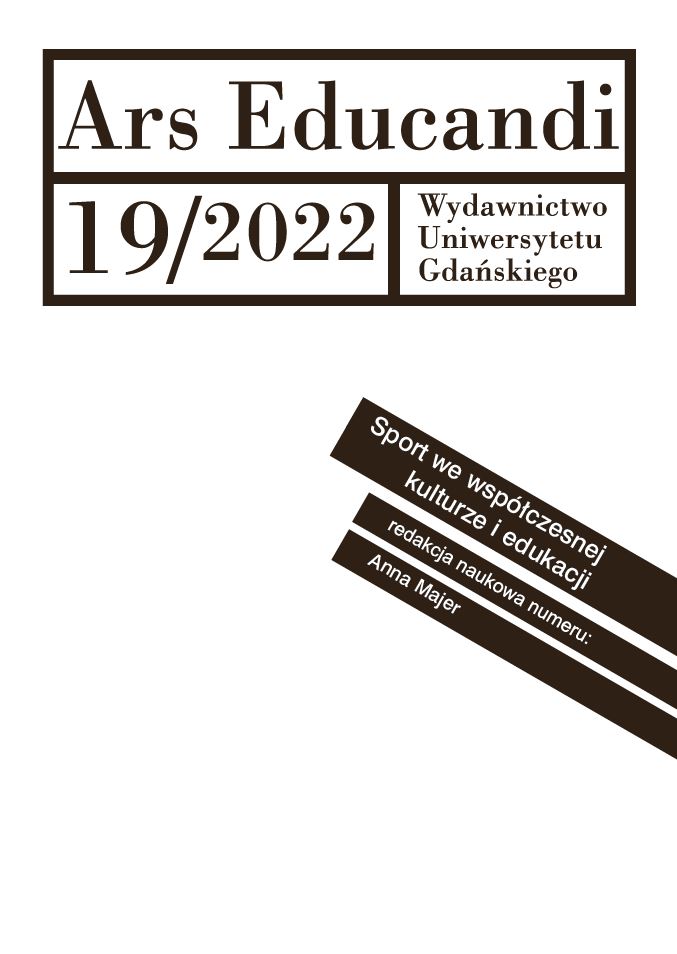Czy Norwedzy wiedzą lepiej?
Do the Norwegians know better? Physical activity as a basic need and right of children
DOI:
https://doi.org/10.26881/ae.2022.19.03Keywords:
preschool education, norwegian kindergarten, physical activity in kindergartenAbstract
The article aims to show the relationship between physical activity and human health and development, with the greatest emphasis on preschool age. It shows a gap in research in this field in Poland and indicates important directions of research (the impact of physical activity on the child's psychophysical development and learning ability, factors influencing the child's physical activity and their correlations). Against this background, the functioning of a systemic kindergarten institution, both Polish and Norwegian, is presented in order to provoke reflection among adults caring for children aged 3-7.
Downloads
References
Feldenkrais M., “Embodied Wisdom: The Collected Papers of Moshe Feldenkrais”, North Atlantic Books, Berkeley, California, 2010.
Gniewkowski W., Wlaźnik K., „Wychowanie fizyczne”, WSiP, Warszawa 1990.
Jane E. Clark (2007) On the Problem of Motor Skill Development, Journal of Physical Education, Recreation & Dance, 78:5, 39-44, DOI: 10.1080/07303084.2007.10598023.
Louve Richard, “Ostatnie dziecko lasu”, Relacja, Warszawa 2014.
Myer GD, Faigenbaum AD, Edwards NM, Clark JF, Best TM, Sallis RE. Sixty minutes of what? A developing brain perspective for activating children with an integrative exercise approach. Br J Sports Med. 2015 Dec;49(23):1510-6. doi: 10.1136/bjsports-2014-093661. Epub 2015 Jan 23. PMID: 25617423.
Duncan, G. J., Dowsett, C. J., Claessens, A., Magnuson, K., Huston, A. C., Klebanov, P., . . . Brooks-Gunn, J. (2007). School readiness and later achievement. Developmental Psychology, 43(6), 1428.
Carson, V., Rahman, A. A., & Wiebe, S. A. (2017). Associations of subjectively and objectively measured sedentary behavior and physical activity with cognitive development in the early years. Mental Health and Physical Activity, 13, 1–8. https://doi.org/10.1016/j.mhpa.2017.05.003
Hinkley T, Salmon J, Okely AD, Crawford D, Hesketh K. Preschoolers' physical activity, screen time, and compliance with recommendations. Med Sci Sports Exerc. 2012 Mar;44(3):458-65. doi: 10.1249/MSS.0b013e318233763b. PMID: 21900847.
Becker, Derek. R., Grist, Cathy L., Caudle, Lori A., & Watson, Myra K. (2018). Complex physical activity, outdoor play, and school readiness among preschoolers. Global Education Review, 5 (2), 110-122.
Becker, Derek R., McClelland,Megan M., Paul Loprinzi & Stewart G. Trost (2014) Physical Activity, Self-Regulation, and Early Academic Achievement in Preschool Children, Early Education and Development, 25:1, 56-70, DOI: 10.1080/10409289.2013.780505
Lan, B.Y. and Guo, X.Y. (2021) Research on the Influencing Factors of Kindergarten on Children’s Physical Activity. Open Access Library Journal, 8: e7832.https://doi.org/10.4236/oalib.1107832.
Bois, J.E., Sarrazin, P.G., Brustad, R.J., Trouilloud, D.O. and Cury, F. (2005) Elementary Schoolchildren’s Perceived Competence and Physical Activity Involve- ment: The Influence of Parents’ Role Modelling Behaviours and Perceptions of Their Childs Competence. Psychology of Sport & Exercise, 6, 381-397. https://doi.org/10.1016/j.psychsport.2004.03.003.
Zhou, J. (2018) Research on the Influence of Outdoor Environment in Kindergarten on Children’s Physical Activities. Beijing Sport University, Beijing.
Rozporządzenie Ministra Edukacji Narodowej z 28 sierpnia 2017 r. w sprawie rodzajów innych form wychowania przedszkolnego, warunków tworzenia i organizowania tych form oraz sposobu ich działania (Dz.U. z 2020 r. poz. 1520)..
MEN Podstawa programowa wychowania przedszkolnego i kształcenia ogólnego dla szkoły podstawowej , https://www.ore.edu.pl/nowa-podstawa-programowa/WYCHOWANIE%20PRZEDSZKOLNE,%20EDUKACJA%20WCZESNOSZKOLNA/Podstawa%20programowa%20wychowania%20przedszkolnego%20i%20kształcenia%20ogólnego%20dla%20szkoły%20podstawowej%20z%20komentarzem.pdf.
K. Johannessen, E. Bjørnestad, A. K. O. Nilsen, E. Ylvisåker, M. Nornes-Nymark, M. Engsæter, L. Pedersen, & E. Aadland. «Associations for preschool environmental quality with outdoor time and moderate-to-vigorous physical activity in Norwegian preschools». Journal for Research in Arts and Sports Education, Special Issue: Fysisk aktivitet, kropp og bevegelse i barnehagen, Vol. 4(2), 2020, pp. 7–25. http://dx.doi.org/10.23865/jased.v4.2485.
Chawla, L., & Nasar, J. L. (2015). Benefits of nature contact for children.
Journal of Planning Literature, 30 (4), 433–452. https://doi.org/10.1177/0885412215595441
New, R. S., Mardell, B., & Robinson, D. (2005). Early childhood education as risky business: Going beyond what’s “safe” to discovering what’s possible. Early Childhood Research and Practice, 7 (2), 1–21. https://files.eric.ed.gov/fulltext/EJ1084843.pdf
WHO. (2019).
Guidelines on physical activity, sedentary behaviour and sleep for children under 5 years of age. From https://apps.who.int/iris/handle/10665/311664.
The Norwegian Directorate for Education and Training. (2017). Framework plan for Kindergartens. https://www.udir.no/globalassets/filer/barnehage/rammeplan/rammeplan-for-barnehagen-bokmal 2017.pdf
Bingham, D. D., Costa, S., Hinkley, T., Shire, K. A., Clemes, S. A., & Barber, S. E. (2016). Physical activity during the early years: A systematic review of correlates and determinants.
American Journal of Preventive Medicine, 51 (3), 384–402. https://doi.org/10.1016/j.amepre.2016.04.022

 Academic Scientific Journals
Academic Scientific Journals




